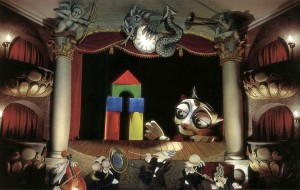Dramaturgy, puppets, and scenery: Fabiola Garrido and Enrique Lanz
Music: Enrique Rueda
Staging and lighting: Enrique Lanz
Production: Etcétera (with the collaboration of the Junta de Andalucía)
Released November 1990, Amaia Cultural Center, Irun.
Trans has been — and continues to be — a performance benchmark in theater with puppets made in Andalusia. The critic, Miguel Martín Rubí, wrote that to him, Etcétera had returned to demonstrate that it was uniquely capable of entertaining the audience, making it believe that what was high technology was only savvy craftsmanship, and that what seemed simple was technically and conceptually complex. Trans is not just theater based in art that uses various techniques of animating puppets and objects, which takes full advantage of expressive capacity, aesthetic emotion, and subtle and suggestive language, but rather it is a concept with multiple meanings and surprises, cast in a suggestive and personal vision of reality.
A child loses his pet monkey and scours the city in search of it while experiencing numerous events. This seemingly simple fable weaves a complex drama that mixes reality, nightmares, and dreams.
In the first two versions of Trans (1990 and 1991) the addition of a dreamlike and sensitive ambience shaped a dramatic universe through images, sounds, and silences. In 2003, after nearly two hundred fifty productions in different countries, Enrique Lanz presented a new version that included much of the original production’s set design, but expanded the size of the small grand puppet theater where the story unfolds. A story that, following the company’s evolution, integrated piano music performed live by the composer, Enrique Rueda, and the presence of an actor who accompanied what was happening on stage with his poetic narrative.
Trans toured for ten years, achieving success at European festivals. In Iran, for example, in 1994 it was selected as the best show of the Tehran puppet festival.
















